Indesit IWB 61451 User Manual [de]

Instructions for use
WASHING MACHINE
GB |
|
DE |
|
FR |
|
|
|
|
|
|
|
English,1 |
Deutsch,13 |
Français,25 |
|||
Contents |
GB |
|
Installation, 2-3
Unpacking and levelling
Connecting the electricity and water supplies
The first wash cycle
Technical data
NL
Nederlands,37
Care and maintenance, 4
Cutting off the water or electricity supply Cleaning the washing machine Cleaning the detergent dispenser drawer
Caring for the door and drum of your appliance Cleaning the pump
Checking the water inlet hose
IWB 61451
Precautions and tips, 5
General safety
Disposal
Description of the washing machine and starting a wash cycle, 6-7
Control panel Indicator lights Starting a wash cycle
Wash cycles, 8
Table of wash cycles
Personalisation, 9
Setting the temperature
Functions
Detergents and laundry, 10
Detergent dispenser drawer Preparing the laundry Garments requiring special care Load balancing system
Troubleshooting, 11
Service, 12
1
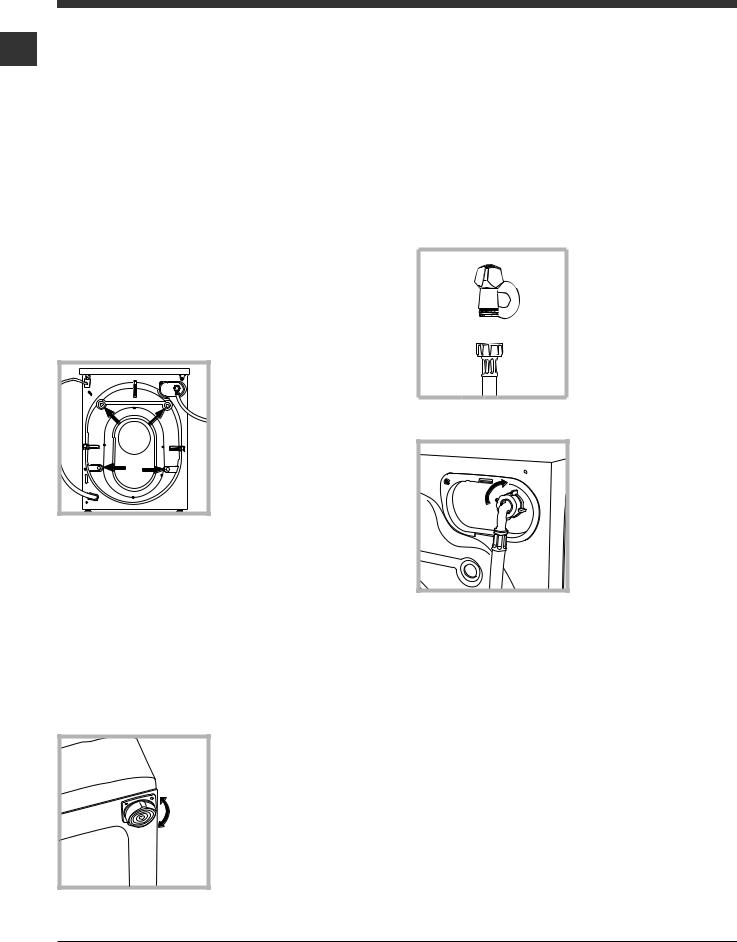
Installation
! This instruction manual should be kept in a safe GB place for future reference. If the washing machine is sold, transferred or moved, make sure that the instruction manual remains with the machine so that the new owner is able to familiarise him-
self/herself with its operation and features.
! Read these instructions carefully: they contain vital information relating to the safe installation and operation of the appliance.
Unpacking and levelling
Unpacking
1.Remove the washing machine from its packaging.
2.Make sure that the washing machine has not been damaged during the transportation process. If it has been damaged, contact the retailer and do not proceed any further with the installation process.
3.Remove the 4 pro-
tective screws (used during transportation) and the rubber washer with the corresponding spacer, located on the rear part of the appliance (see figure).
4.Close off the holes using the plastic plugs provided.
5.Keep all the parts in a safe place: you will need them again if the washing machine needs to be moved to another location.
! Packaging materials should not be used as toys for children.
Levelling
1. Install the washing machine on a flat sturdy floor, without resting it up against walls, furniture cabinets or anything else.
2. If the floor is not perfectly level, compensate for any unevenness by tightening
or loosening the adjustable front feet (see figure); the angle of inclination, measured in relation to the worktop, must not exceed 2°.
Levelling the machine correctly will provide it with stability, help to avoid vibrations and excessive noise and prevent it from shifting
while it is operating. If it is placed on carpet or a rug, adjust the feet in such a way as to allow a sufficient ventilation space underneath the washing machine.
Connecting the electricity and water supplies
Connecting the water inlet hose
1. Connect the supply pipe by screwing it to a cold water tab using a ¾ gas threaded connection (see
figure).
Before performing the connection, allow the water to run freely until it is perfectly clear.
2. Connect the inlet hose to the washing machine by screwing it onto the corresponding water inlet of the appliance, which is situated on the top right-hand side of the rear part of the appliance (see figure).
3. Make sure that the hose is not folded over or bent.
!The water pressure at the tap must fall within the values indicated in the Technical details table (see next page).
!If the inlet hose is not long enough, contact a specialised shop or an authorised technician.
!Never use second-hand hoses.
!Use the ones supplied with the machine.
2
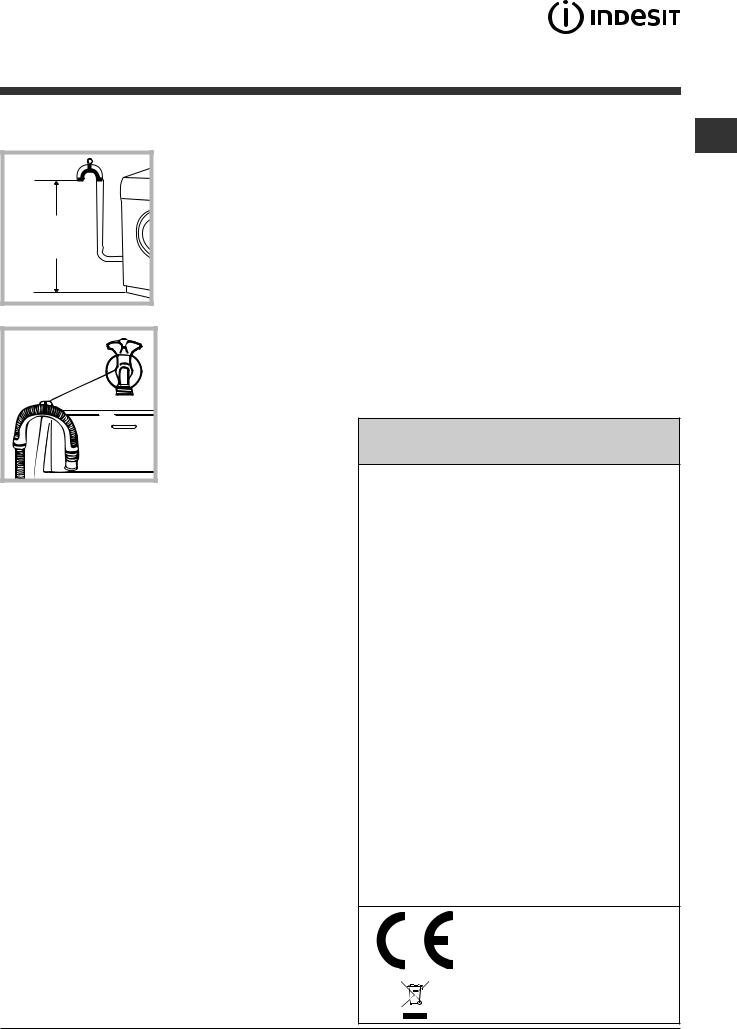
Connecting the drain hose
65 - 100 cm |
Connect the drain hose, without bending it, to a drainage duct or a wall drain located at a height between 65 and 100 cm from the floor;
alternatively, rest it on the side of a washbasin or bathtub, fastening the duct supplied to the tap (see figure). The free end of the hose should not be underwater.
! We advise against the use of hose extensions; if it is absolutely necessary, the extension must have the same diameter as the original hose and must not exceed 150 cm in length.
Electrical connections
Before plugging the appliance into the electricity socket, make sure that:
•the socket is earthed and complies with all applicable laws;
•the socket is able to withstand the maximum power load of the appliance as indicated in the Technical data table (see opposite);
•the power supply voltage falls within the values indicated in the Technical data table
(see opposite);
•the socket is compatible with the plug of the washing machine. If this is not the case, replace the socket or the plug.
!The washing machine must not be installed outdoors, even in covered areas. It is extremely dangerous to leave the appliance exposed to rain, storms and other weather conditions.
!When the washing machine has been installed, the electricity socket must be within easy reach.
! Do not use extension cords or multiple sockets. |
GB |
|
!The cable should not be bent or compressed.
!The power supply cable must only be replaced by authorised technicians.
Warning! The company shall not be held responsible in the event that these regulations are not respected.
The first wash cycle
Once the appliance has been installed, and before you use it for the first time, run a wash cycle with detergent and no laundry, using the wash cycle 2.
Technical data
Model |
IWB 61451 |
|
|
|
|
|
width 59.5 cm |
|
Dimensions |
height 85 cm |
|
|
depth 53,5 cm |
|
Capacity |
from 1 to 6 kg |
|
|
|
|
Electrical |
please refer to the technical |
|
data plate fixed to the ma- |
||
connections |
||
chine |
||
|
|
|
|
maximum pressure 1 MPa |
|
Water con- |
(10 bar) |
|
minimum pressure 0.05 |
||
nection |
MPa (0.5 bar) |
|
|
drum capacity 52 litres |
|
|
|
|
Spin speed |
up to 1400 rotations per |
|
minute |
||
Test wash |
|
|
cycles in |
Programme 2: Cotton stan- |
|
accordan- |
||
ce with |
dard 60°C; |
|
directives |
Programme 3: Cotton stan- |
|
1061/2010 |
dard 40°C. |
|
and |
|
|
1015/2010 |
|
This appliance conforms to the following EC Directives:
-2004/108/EC (Electromagnetic Compatibility)
-2012/19/EU
- 2006/95/EC Low Voltage)
3

Care and maintenance
|
Cutting off the water and electri- |
|
GB |
||
city supplies |
||
|
• Turn off the water tap after every wash cycle. |
|
|
This will limit wear on the hydraulic system |
|
|
inside the washing machine and help to pre- |
|
|
vent leaks. |
|
|
• Unplug the washing machine when cleaning |
|
|
it and during all maintenance work. |
Cleaning the washing machine
The outer parts and rubber components of the appliance can be cleaned using a soft cloth soaked in lukewarm soapy water. Do not use solvents or abrasives.
Cleaning the detergent dispenser drawer
Remove the dispenser by raising it and pulling it out (see figure). Wash it under running water; this operation should be repeated frequently.
2. unscrew the lid by rotating it anticlockwise (see figure): a little water may trickle out. This is perfectly normal;
3.clean the inside thoroughly;
4.screw the lid back on;
5.reposition the panel, making sure the hooks are securely in place before you push it onto the appliance.
Checking the water inlet hose
Check the inlet hose at least once a year. If there are any cracks, it should be replaced immediately: during the wash cycles, water pressure is very strong and a cracked hose could easily split open.
! Never use second-hand hoses.
Caring for the door and drum of your appliance
•Always leave the porthole door ajar in order to prevent unpleasant odours from forming.
Cleaning the pump
The washing machine is fitted with a self-cle- aning pump which does not require any maintenance. Sometimes, small items (such as coins or buttons) may fall into the pre-chamber which protects the pump, situated in its bottom part.
! Make sure the wash cycle has finished and unplug the appliance.
To access the prechamber:
1. using a screwdriver, remove the cover panel on the lower front part of the washing machine (see figure);
4

Precautions and tips
! This washing machine was designed and constructed in accordance with international safety regulations. The following information is provided for safety reasons and must therefore be read carefully.
Consumers should contact their local authority or
retailer for information concerning the correct GB disposal of their old appliance.
General safety
•This appliance was designed for domestic use only.
•This appliance can be used by children aged
from 8 years and above and persons with reduced physical, sensory or mental capabilities or lack of experience and knowledge if they have been given supervision or instruction concerning use of the appliance in a safe way and understand the hazards involved. Children shall not play with the appliance. Cleaning and user maintenance shall not be made by children without supervision.
•Do not touch the machine when barefoot or with wet or damp hands or feet.
•Do not pull on the power supply cable when unplugging the appliance from the electricity socket. Hold the plug and pull.
•Do not open the detergent dispenser drawer while the machine is in operation.
•Do not touch the drained water as it may reach extremely high temperatures.
•Never force the porthole door. This could damage the safety lock mechanism designed to prevent accidental opening.
•If the appliance breaks down, do not under any circumstances access the internal mechanisms in an attempt to repair it yourself.
•Always keep children well away from the appliance while it is operating.
•The door can become quite hot during the wash cycle.
•If the appliance has to be moved, work in a group of two or three people and handle it with the utmost care. Never try to do this alone, because the appliance is very heavy.
•Before loading laundry into the washing machine, make sure the drum is empty.
Disposal
•Disposing of the packaging materials: observe local regulations so that the packaging may be re-used.
•The European Directive 2012/19/EU on Waste Electrical and Electronic Equipment, requires that old household electrical appliances must not be disposed of in the normal unsorted municipal waste stream. Old appliances must be collected separately in order to optimise the recovery and recycling of the
materials they contain and reduce the impact on human health and the environment. The crossed out “wheeled bin” symbol on the product reminds you of your obligation, that when you dispose of the appliance it must be separately collected.
5

Description of the washing machine and starting a wash cycle
Control panel
GB
ON/OFF button
Detergent dispenser drawer
WASH CYCLE knob
Detergent dispenser drawer: used to dispense detergents and washing additives (see “Detergents and laundry”).
ON/OFF button: switches the washing machine on and off.
WASH CYCLE knob: programmes the wash cycles. During the wash cycle, the knob does not move.
FUNCTION buttons with indicator light: used to select the available functions. The indicator light corresponding to the selected function will remain lit.
TEMPERATURE knob: sets the temperature or the cold wash cycle (see “Personalisation”).
WASHCYCLEPROGRESS/DELAYTIMERindicatorlights: used to monitor the progress of the wash cycle.
Theilluminatedindicatorlightshowswhichphaseisinprogress. If the Delay Timer function has been set, the time remaining until the wash cycle starts will be indicated (see next page).
DOOR LOCKED indicator light: indicates whether the door may be opened or not (see next page).
WASH CYCLE PROGRESS/
DELAY TIMER indicator lights
FUNCTION |
START/ |
|
PAUSE |
||
buttons with |
||
indicator lights |
button with |
|
indicator light |
||
|
TEMPERATURE |
|
|
|
|
|
|
|
|
|
|
|
|
DOOR LOCKED |
||||
knob |
|
||||
|
|||||
|
|
indicator light |
|||
START/PAUSE button with indicator light: starts or temporarily interrupts the wash cycles.
N.B. To pause the wash cycle in progress, press this button; the corresponding indicator light will flash orange, while the indicator light for the current wash cycle phase will remain lit in a fixed manner. If the DOOR LOCKED  indicator light is switched off, the door may be opened (wait approximately 3 minutes).
indicator light is switched off, the door may be opened (wait approximately 3 minutes).
To start the wash cycle from the point at which it was interrupted, press this button again.
Standby mode
This washing machine, in compliance with new energy saving regulations, is fitted with an automatic standby system which is enabled after about 30 minutes if no activity is detected. Press the ON-OFF button briefly and wait for the machine to start up again.
6
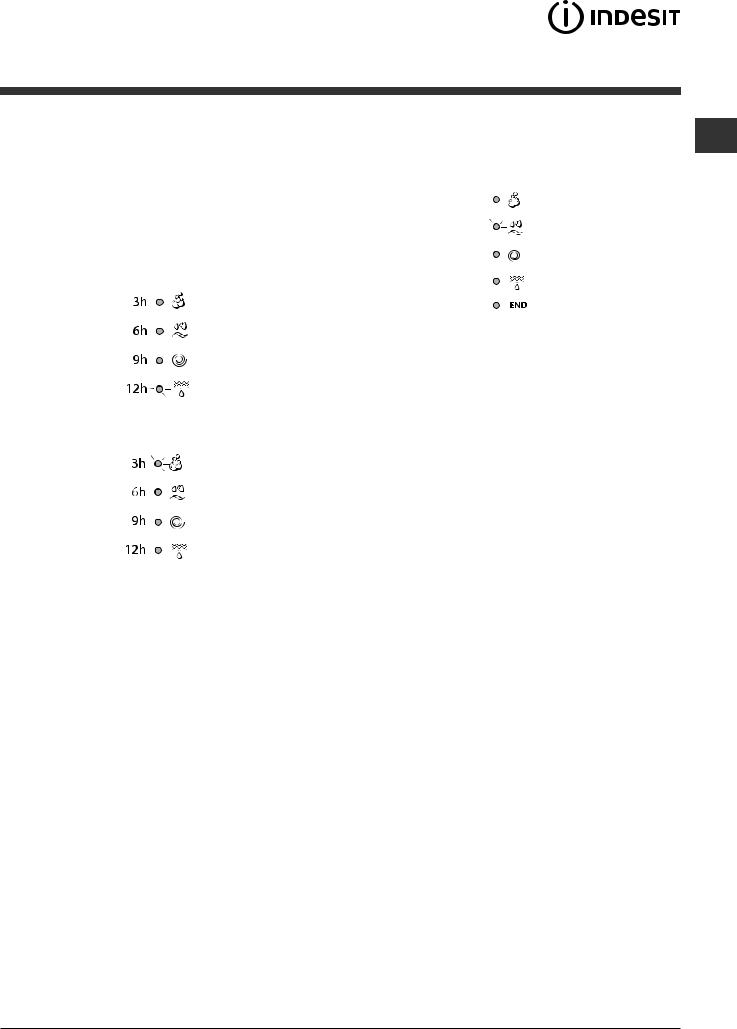
Indicator lights
The indicator lights provide important information. This is what they can tell you:
Delayed start
If the DELAY TIMER function has been activated (see “Personalisation”), after the wash cycle has been started the indicator light corresponding to the selected delay period will begin to flash:
As time passes, the remaining delay will be displayed and the corresponding indicator light will flash:
The set programme will start once the selected time delay has expired.
Wash cycle phase indicator lights
Once the desired wash cycle has been selected and has be- GB gun, the indicator lights switch on one by one to indicate which
phase of the cycle is currently in progress.
Wash
Rinse
Spin
Drain
End of wash cycle
Function buttons and corresponding indicator lights
When a function is selected, the corresponding indicator light will illuminate.
If the selected function is not compatible with the programmed wash cycle, the corresponding indicator light will flash and the function will not be activated.
If the selected function is not compatible with another function which has been selected previously, the indicator light corresponding to the first function selected will
flash and only the second function will be activated; the indicator light corresponding to the enabled option will
remain lit.
 Door locked indicator light
Door locked indicator light
When the indicator light is on, the porthole door is locked to prevent it from being opened; make sure the indicator light is off before opening the door (wait approximately 3 minutes). To open the door during a running wash cycle, press the START/PAUSE button; the door may be opened once the DOOR LOCKED indicator light turns off.
Starting a wash cycle
1.Switch the washing machine on by pressing the ON/OFF button. All indicator lights will switch on for a few seconds, then they will switch off and the START/PAUSE indicator light will pulse.
2.Load the laundry and close the door.
3.Set the WASH CYCLE knob to the desired programme.
4.Set the washing temperature (see “Personalisation”).
5.Measure out the detergent and washing additives (see “Detergents and laundry”).
6.Select the desired functions.
7.Start the wash cycle by pressing the START/PAUSE button and the corresponding indicator light will remain lit in a fixed manner, in green. To cancel the set wash cycle, pause the machine by pressing the START/PAUSE button and select a new cycle.
8.At the end of the wash cycle the
 indicator light will switch on. The door can be opened once the DOOR LOCKED
indicator light will switch on. The door can be opened once the DOOR LOCKED  indicator light turns off (wait approximately 3 minutes). Take out your laundry and leave the appliance door ajar to make sure the drum dries completely. Switch the washing machine off by pressing the ON/OFF button.
indicator light turns off (wait approximately 3 minutes). Take out your laundry and leave the appliance door ajar to make sure the drum dries completely. Switch the washing machine off by pressing the ON/OFF button.
7
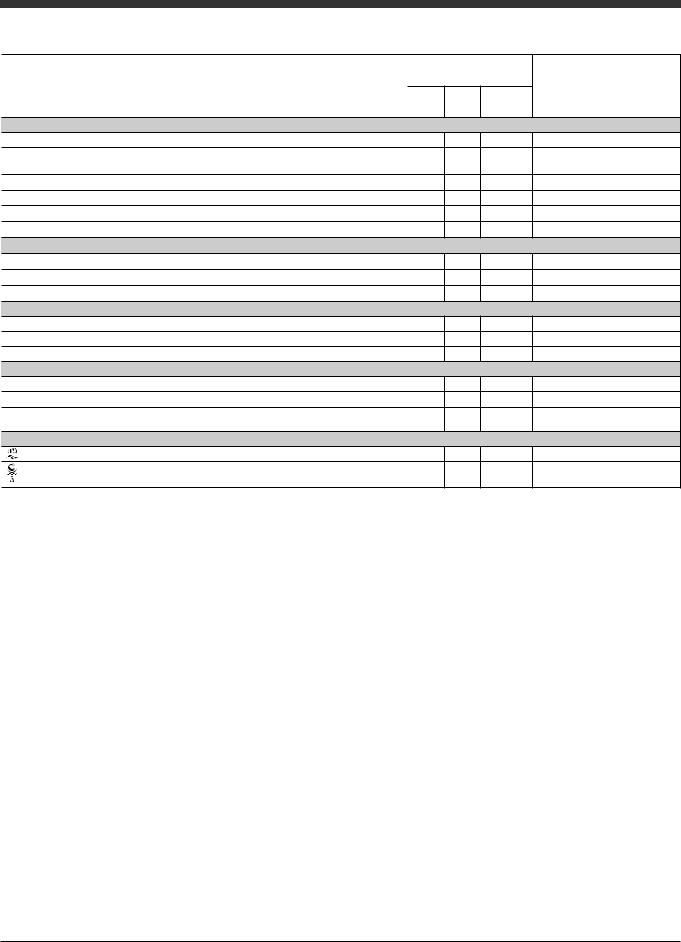
Wash cycles
|
Table of wash cycles |
|
|
|
|||
GB |
|
|
|
||||
|
cycles |
|
|
|
|
|
|
|
|
|
|
Max. |
Max. |
|
|
|
|
|
|
||||
|
|
Wash |
|
Description of the wash cycle |
temp. |
speed |
|
|
|
|
|
(°C) |
(rpm) |
Pre- |
|
|
|
|
|
|
|
|
wash |
|
|
|
|
Daily |
|
|
|
|
|
|
|
|
|
|
|
|
|
1 |
|
Cotton with prewash: extremely soiled whites. |
90° |
1400 |
|
|
|
2 |
|
Cotton Standard 60° (1): heavily soiled whites and resistant colours. |
60° |
1400 |
- |
|
|
|
(Max. 90°) |
||||
|
|
3 |
|
Cotton Standard 40° (2): lightly soiled whites and delicate colours. |
40° |
1400 |
- |
|
|
4 |
|
Synthetics: heavily soiled resistant colours. |
60° |
800 |
- |
|
|
4 |
|
Synthetics (3): lightly soiled resistant colours. |
40° |
800 |
- |
|
|
5 |
|
Mix Colored: lightly soiled whites and delicate colours. |
40° |
1400 |
- |
|
|
|
|
20° Zone |
|
|
|
|
|
6 |
|
Cotton Standard 20°: lightly soiled whites and delicate colours. |
|
|
|
|
|
|
20° |
1400 |
- |
||
|
|
7 |
|
Mix Light |
20° |
800 |
- |
|
|
8 |
|
20’ Refresh |
20° |
800 |
- |
|
|
|
|
Special |
|
|
|
|
|
9 |
|
Silk/Curtains: for garments in silk and viscose, lingerie. |
30° |
0 |
- |
|
|
10 |
|
Wool: for wool, cashmere, etc. |
40° |
800 |
- |
|
|
11 |
|
Jeans |
40° |
800 |
- |
|
|
|
|
Sport |
|
|
|
|
|
12 |
|
Sport Intensive |
30° |
600 |
- |
|
|
13 |
|
Sport Light |
30° |
600 |
- |
|
|
14 |
|
Sport Shoes |
30° |
600 |
- |
|
|
|
|
Partial wash cycles |
|
|
|
|
|
|
|
|
|
|
|
|
|
|
|
Rinse |
- |
1400 |
- |
|
|
|
|
Spin + Drain |
- |
1400 |
- |
|
|
|
|
|
|
|
|
Detergents
Wash softenerFabric
-
--
Max. load (kg) |
Residual dampness% |
Energy consumption kWh |
Total water lt |
Cycle duration |
6 |
|
|
|
170’ |
53 |
2,21 |
78 |
||
6 |
53 |
1,05 |
50,0 |
195’ |
6 |
53 |
0,86 |
69 |
180’ |
3,5 |
44 |
0,93 |
47 |
115’ |
3,5 |
44 |
0,57 |
46 |
100’ |
6 |
53 |
0,66 |
54 |
90’ |
6 |
|
|
|
170’ |
- |
- |
- |
||
6 |
- |
- |
- |
120’ |
1,5 |
- |
- |
- |
20’ |
1 |
|
|
|
55’ |
- |
- |
- |
||
1,5 |
- |
- |
- |
70’ |
3,5 |
- |
- |
- |
75’ |
2,5 |
|
|
|
85’ |
- |
- |
- |
||
2,5 |
- |
- |
- |
60’ |
Max. 2 |
- |
- |
- |
60’ |
Pairs |
|
|
|
|
6 |
|
|
|
36’ |
- |
- |
- |
||
6 |
- |
- |
- |
16’ |
|
|
|
|
|
The length of cycle shown on the display or in this booklet is an estimation only and is calculated assuming standard working conditions. The actual duration can vary according to factors such as water temperature and pressure, the amount of detergent used, the amount and type of load inserted, load balancing and any wash options selected.
1) Test wash cycle in compliance with directive 1061/2010: set wash cycle 2 with a temperature of 60°C.
This cycle is designed for cotton loads with a normal soil level and is the most efficient in terms of both electricity and water consumption; it should be used for garments which can be washed at 60°C. The actual washing temperature may differ from the indicated value.
2) Test wash cycle in compliance with directive 1061/2010: set wash cycle 3 with a temperature of 40°C.
This cycle is designed for cotton loads with a normal soil level and is the most efficient in terms of both electricity and water consumption; it should be used for garments which can be washed at 40°C. The actual washing temperature may differ from the indicated value.
For all Test Institutes:
2)Long wash cycle for cottons: set wash cycle 3 with a temperature of 40°C.
3)Synthetic program along: set wash cycle 4 with a temperature of 40°C.
Sport Intensive (wash cycle 12) is for washing heavily soiled sports clothing fabrics (tracksuits, shorts, etc.); for best results, we recommend not exceeding the maximum load indicated in the “Table of wash cycles”.
Sport Light (wash cycle 13) is for washing lightly soiled sports clothing fabrics (tracksuits, shorts, etc.); for best results, we recommend not exceeding the maximum load indicated in the “Table of wash cycles”. We recommend using a liquid detergent and dosage suitable for a half-load.
Sport Shoes (wash cycle 14) is for washing sports shoes; for best results, do not wash more than 2 pairs simultaneously.
The 20° wash cycles (20° Zone) offer effective washing performance at low temperatures, reducing electricity usage and expenditure while benefitting the environment.The 20° wash cycles meet all requirements:
Cotton Standard 20° (programme 6) ideal for lightly soiled cotton loads. The effective performance levels achieved at cold temperatures, which are comparable to washing at 40°, are guaranteed by a mechanical action which operates at varying speed, with repeated and frequent peaks.
Mix Light (programme 7) ideal for mixed loads (cotton and synthetics) with a normal soil level. The effective performance levels achieved at cold temperatures are guaranteed by a mechanical action which operates at varying speed, across set average intervals.
20’ Refresh (programme 8) ideal for refreshing and washing lightly soiled garments in a few minutes. It lasts just 20 minutes and therefore saves both time and energy. It can be used to wash different types of fabrics together (except for wool and silk), with a maximum load of 1.5 kg.
8

Personalisation
|
|
|
Setting the temperature |
GB |
|
Turn the TEMPERATURE knob to set the wash temperature (see Table of wash cycles). |
||
|
The temperature may be lowered, or even set to a cold wash  .
.
The washing machine will automatically prevent you from selecting a temperature which is higher than the maximum value set for each wash cycle.
! Exception: if the 2 programme is selected, the temperature can be increased up to a value of 90°C.
Functions
The various wash functions available with this washing machine will help to achieve the desired results, every time. To activate the functions:
1.Press the button corresponding to the desired function;
2.the function is enabled when the corresponding indicator light is illuminated.
Note: If the indicator light flashes rapidly, this signals that this particular function may not be selected in conjunction with the selected wash cycle.
Selecting this option enables you to suitably adjust drum rotation, temperature and water to a reduced load of lightly soiled cotton and synthetic fabrics (refer to the “Table of wash cycles”). “


 ” enables you to wash in less time thereby saving water and electricity. We suggest using a liquid detergent suitably measured out to the load quantity.
” enables you to wash in less time thereby saving water and electricity. We suggest using a liquid detergent suitably measured out to the load quantity.
! This function may not be used in conjunction with wash cycles 1, 2 (>60°), 6, 7, 8, 9, 10, 11, 12, 13, 14,  ,
,  .
.
The 




 function saves energy by not heating the water used to wash your laundry - an advantage both to the environment and to your energy bill. Instead, intensified wash action and water optimisation ensure great wash results in the same average time of a standard cycle.
function saves energy by not heating the water used to wash your laundry - an advantage both to the environment and to your energy bill. Instead, intensified wash action and water optimisation ensure great wash results in the same average time of a standard cycle.
For the best washing results we recommend the usage of a liquid detergent. ! It cannot be used with the 1, 6, 7, 8, 9, 10, 12, 13, 14,  ,
,  , programmes.
, programmes.
 1400-600
1400-600
Press this button to reduce the spin speed.
! This function may not be used in conjunction with cycles 9.
 Delay timer
Delay timer
This timer delays the start time of the wash cycle by up to 12 hours.
Press the button repeatedly until the indicator light corresponding to the desired delay time switches on. The fifth time the button is pressed, the function will be disabled.
N.B. Once the START/PAUSE button has been pressed, the delay time can only be modified by decreasing it until launching the set programme.
! This option is enabled with all programmes.
9

Detergents and laundry
Detergent dispenser drawer
GB
Good washing results also depend on the correct dose of detergent: adding too much detergent will not necessarily result in a more efficient wash, and may in fact cause build up on the inside of your appliance and contribute to environmental pollution.
!Do not use hand washing detergents because these create too much foam.
!Use powder detergent for white cotton garments, for prewashing, and for washing at temperatures over 60°C.
!Follow the instructions given on the detergent packaging.
Open the detergent dispenser drawer and pour in the detergent or washing
additive, as follows.
3
1 2
compartment 1: Pre-wash detergent (powder) compartment 2: Detergent for the wash cycle (powder or liquid)
Liquid detergent should only be poured in immediately prior to the start of the wash cycle.
compartment 3: Additives (fabric softeners, etc.)
The fabric softener should not overflow the grid.
Preparing the laundry
•Divide the laundry according to:
-the type of fabric/the symbol on the label
-the colours: separate coloured garments from whites.
•Empty all garment pockets and check the buttons.
•Do not exceed the values listed in the “Table of wash cycles”, which refer to the weight of the laundry when dry.
How much does your laundry weigh?
1 sheet 400-500 g
1 pillow case 150-200 g
1 tablecloth 400-500 g
1 bathrobe 900-1200 g
1 towel 150-250 g
Garments requiring special care
Silk: use special wash cycle 9 to wash all silk garments. We recommend the use of special detergent which has been designed to wash delicate clothes.
Curtains: fold curtains and place them in a pillow case or mesh bag. Use wash cycle 9.
Wool: all wool garments can be washed using programme 10, even those carrying the “hand-wash only”  label. For best results, use special detergents and do not exceed 1,5 kg of laundry.
label. For best results, use special detergents and do not exceed 1,5 kg of laundry.
Jeans: Turn garments inside-out before washing and use a liquid detergent. Use programme 11.
Load balancing system
Before every spin cycle, to avoid excessive vibrations and to distribute the load in a uniform manner, the drum rotates continuously at a speed which is slightly greater than the washing rotation speed. If, after several attempts, the load is not balanced correctly, the machine spins at a reduced spin speed. If the load is excessively unbalanced, the washing machine performs the distribution process instead of spinning. To encourage improved load distribution and balance, we recommend small and large garments are mixed in the load.
10

Troubleshooting
|
|
|
|
|
Your washing machine could fail to work. Before contacting the Technical Assistance Centre (see “Assistance”), make sure |
|
|||
GB |
||||
that the problem cannot be not solved easily using the following list. |
||||
|
||||
Problem: |
Possible causes / Solutions: |
|
||
|
||||
The washing machine does not switch on.
The wash cycle does not start.
•The appliance is not plugged into the socket fully, or is not making contact.
•There is no power in the house.
•The washing machine door is not closed properly.
•The ON/OFF button has not been pressed.
•The START/PAUSE button has not been pressed.
•The water tap has not been opened.
•A delayed start has been set (see “Personalisation”).
The washing machine does not take in water (the indicator light for the first wash cycle stage flashes rapidly).
•The water inlet hose is not connected to the tap.
•The hose is bent.
•The water tap has not been opened.
•There is no water supply in the house.
•The pressure is too low.
•The START/PAUSE button has not been pressed.
The washing machine continuously takes in and drains water.
•The drain hose is not fitted at a height between 65 and 100 cm from the floor (see “Installation”).
•The free end of the hose is under water (see “Installation”).
•The wall drainage system is not fitted with a breather pipe.
If the problem persists even after these checks, turn off the water tap, switch the appliance off and contact the Assistance Service. If the dwelling is on one of the upper floors of a building, there may be problems relating to water drainage, causing the washing machine to fill with water and drain continuously. Special anti-draining valves are available in shops and help to avoid this inconvenience.
The washing machine does not drain or spin.
•The wash cycle does not include draining: some wash cycles require the drain phase to be started manually.
•The drain hose is bent (see “Installation”).
•The drainage duct is clogged.
The washing machine vibrates a lot during the spin cycle.
The washing machine leaks.
•The drum was not unlocked correctly during installation (see “Installation”).
•The washing machine is not level (see “Installation”).
•The washing machine is trapped between cabinets and walls (see “Installation”).
•The water inlet hose is not screwed on properly (see “Installation”).
•The detergent dispenser drawer is blocked (for cleaning instructions, see “Care and maintenance”).
•The drain hose is not fixed properly (see “Installation”).
The “Functions” indicator lights and the “start/pause” indicator light flash, while one of the “phase in progress” indicator lights and the “door locked” indicator light will remain lit in a fixed manner.
•Switch off the machine and unplug it, wait for approximately 1 minute and then switch it back on again.
If the problem persists, contact the Technical Assistance Service.
There is too much foam.
•The detergent is not suitable for machine washing (it should display the text “for washing machines” or “hand and machine wash”, or the like).
•Too much detergent was used.
11

Service
|
|
|
|
|
|
Before calling for Assistance: |
|
GB |
|||
|
• Check whether you can solve the problem alone (see “Troubleshooting”); |
||
|
|
• Restart the programme to check whether the problem has been solved; |
|
|
|||
|
|
• If this is not the case, contact an authorised Technical Assistance Centre using the telephone number provided on the |
|
|
|
guarantee certificate. |
|
|
|
! Always request the assistance of authorised technicians. |
Have the following information to hand:
•the type of problem;
•the appliance model (Mod.);
•the serial number (S/N).
This information can be found on the data plate applied to the rear of the washing machine, and can also be found on the front of the appliance by opening the door.
12

Bedienungsanleitungen
WASCHVOLLAUTOMAT
|
|
|
|
|
|
|
INHALTSVERZEICHNIS |
|
|
|
|
|
DE |
|
|
|
|
|
|
|
|
Installation 14-15 |
|
|
DE |
|
|
|
|
|
Auspacken und Aufstellen |
|
|
|
|
|
Wasserund Elektroanschlüsse |
|
|
Deutsch |
|
|
||
Erster Waschgang |
|
|
||
|
|
|
|
|
|
|
Technische Daten |
|
|
|
|
Reinigung und Pflege 16 |
|
|
|
|
Abstellen der Wasserund Stromversorgung |
|
|
|
|
Reinigung des Gerätes |
|
|
|
|
Reinigung der Waschmittelschublade |
|
|
|
|
Pflege der Gerätetür und Trommel |
|
|
|
|
Reinigung der Pumpe |
|
|
|
|
Kontrolle des Wasserzulaufschlauchs |
|
|
IWB 61451
Vorsichtsmaßregeln und Hinweise 17
Allgemeine Sicherheit Entsorgung
Beschreibung des Waschvollautomaten und Starten eines Waschprogramms 18-19
Bedienblende
Kontrollleuchten
Starten eines Waschprogramms
Waschprogramme, 20
Programmtabelle
Personalisierungen 21
Temperatureinstellung
Funktionen
Waschmittel und Wäsche 22
Waschmittelschublade
Vorsortieren der Wäsche
Besondere Wäscheteile
Unwuchtkontrollsystem
Störungen und Abhilfe 23
Kundendienst 24
13
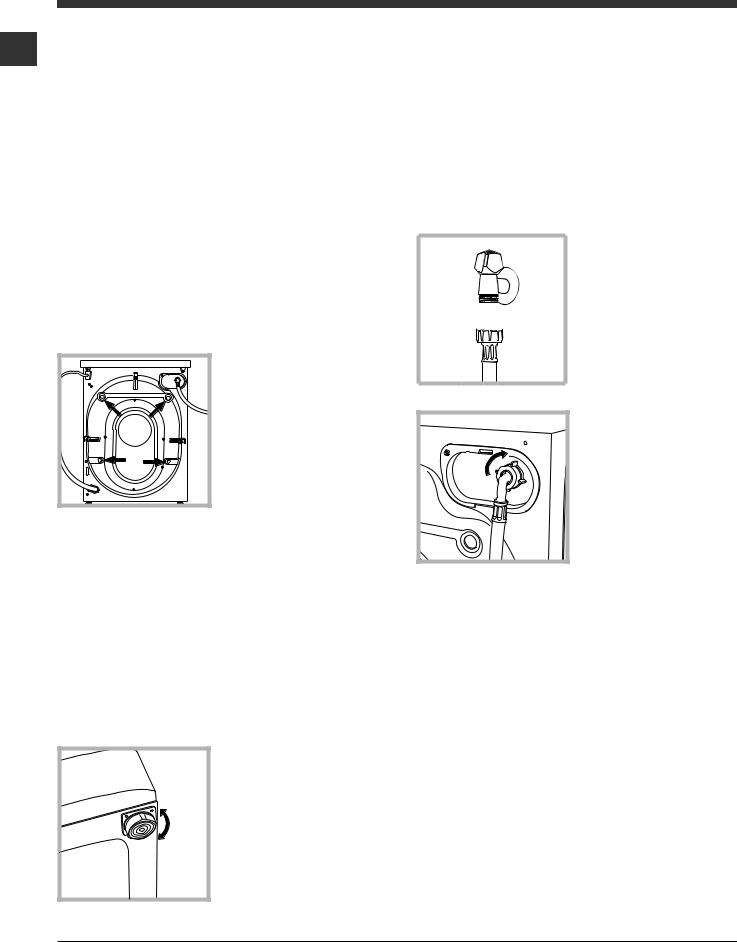
Installation
! Es ist äußerst wichtig, diese Bedienungsanlei- DE tung sorgfältig aufzubewahren, um sie jederzeit
zu Rate ziehen zu können. Sorgen Sie dafür, dass sie im Falle eines Umzugs oder einer Übergabe an einen anderen Benutzer das Gerät stets begleitet, damit auch der neue Inhaber die Möglichkeit hat, diese zu Rate zu ziehen.
! Lesen Sie die Hinweise bitte aufmerksam durch, sie liefern wichtige Informationen hinsichtlich der Installation, des Gebrauchs und der Sicherheit.
Auspacken und Aufstellen
Auspacken
1.Gerät auspacken.
2.Sicherstellen, dass der Waschvollautomat keine Transportschäden erlitten hat. Im Falle einer Beschädigung Gerät bitte nicht anschließen, sondern den Kundendienst anfordern.
3.Die 4 Tran-
sportschutz-schrau- ben herausschrauben und die an der Geräterückwand befindlichen Distanzstücke aus Gummi entfernen (siehe Abbildung).
4.Die Öffnungen mittels der mitgelieferten Abdeckungen verschliessen.
5.Sämtliche Teile aufbewahren: Sollte der Waschautomat erneut transportiert werden, müssen diese Teile wieder eingesetzt werden. ! Verpackungsmaterial ist kein Spielzeug für Kinder.
Nivellierung
1. Der Waschvollautomat muss auf einem ebenen, festen, schwingungsfreien Untergrund aufgestellt werden ohne diesen an Wände, Möbel etc. direkt anzulehnen.
2. Sollte der Boden nicht perfekt eben sein, müssen die Unebenheiten durch
Anbzw. Ausdrehen der vorderen Stellfüße ausgeglichen werden
(siehe Abbildung), der auf der Arbeitsfläche zu ermittelnde Neigungsgrad darf 2°
nicht überschreiten.
Eine präzise Nivellierung verleiht dem Gerät die erforderliche Stabilität, durch die Vibrationen, Betriebsgeräusche und ein Verrücken des Gerätes vermieden werden. Bei Teppichböden müssen die Stellfüße so reguliert werden, dass ein ausreichender Freiraum zur Belüftung unter dem Waschvollautomaten gewährleistet ist.
Wasserund Elektroanschlüsse
Anschluss des Zulaufschlauches
1. Schrauben Sie den Wasserschlauch an einen Kaltwasserhahn
mit ¾-GAS-Gewinde-
anschluss an (siehe Abb.). Lassen Sie das Wasser vor dem Anschluss so lange auslaufen, bis klares Wasser austritt.
2. Das andere Ende des Schlauches an den oben rechts am Rückteil des Waschvollautomaten befindlichen Wasseranschluss anschließen
(siehe Abbildung).
3. Der Schlauch darf hierbei nicht eingeklemmt oder abgeknickt werden.
! Der Wasserdruck muss innerhalb der Werte liegen, die in der Tabelle der technischen Daten angegeben sind (siehe nebenstehende Seite).
!Sollte der Zulaufschlauch nicht lang genug sein, dann wenden Sie sich bitte an einen Fachhändler oder an einen autorisierten Fachmann.
!Verwenden Sie niemals bereits gebrauchte Schläuche.
!Verwenden Sie die Schläuche, die mit dem Gerät geliefert wurden.
14

Anschluss des Ablaufschlauches
|
|
|
Schließen Sie den |
|
|
|
|
|
|
|
Ablaufschlauch ohne |
|
|
|
ihn dabei abzuknicken |
|
|
|
|
|
|
|
an einen geeigneten |
|
|
|
Abfluss an. Die Minde- |
|
|
|
|
65 |
- 100 cm |
stablaufhöhe beträgt |
|
|
|
|
65 - 100 cm (gemes- |
|
|
|
sen vom Boden), oder |
|
|
|
|
|
|
|
hängen Sie diesen |
|
|
|
mittels des Schlau- |
|
|
|
chhalters gesichert in |
ein Becken oder Wanne ein; |
|||
Befestigen Sie diesen mittels des mitgelieferten Schlauchhalters z.B. an einen Wasserhahn (siehe Abbildung). Das freie Ablaufschlauchende darf nicht unter Wasser positioniert wer-
den.
! Verlängerungsschläuche sollten nicht eingesetzt werden. Sollte dies unvermeidlich sein, muss die Verlängerung denselben Durchmesser des Originalschlauchs aufweisen und darf eine Länge von 150 cm nicht überschreiten.
Stromanschluss
Vor Einfügen des Netzsteckers in die Steckdose ist sicherzustellen, dass:
•die Steckdose über eine normgerechte Erdung verfügt;
•die Steckdose die in den Technischen Daten angegebenen Höchstlast des Gerätes trägt
(siehe nebenstehende Tabelle);
• die Stromspannung den in den Technischen Daten angegebenen Werten entspricht (siehe nebentehende Tabelle);
•die Steckdose mit dem Netzstecker des Waschvollautomaten kompatibel ist. An-
dernfalls muss der Netzstecker (oder die Steckdose) ersetzt werden.
!Der Waschvollautomat darf nicht im Freien installiert werden, auch nicht, wenn es sich um einen geschützten Platz handelt. Es ist gefährlich, das Gerät Gewittern und Unwettern auszusetzen.
!Die Steckdose sollte nach installiertem Gerät
leicht zugänglich sein.
! Verwenden Sie bitte keine Verlängerungen |
DE |
oder Mehrfachstecker. |
!Das Netzkabel darf nicht gebogen bzw. eingeklemmt werden.
!Das Versorgungskabel darf nur durch autorisierte Fachkräfte ausgetauscht werden.
Achtung! Der Hersteller übernimmt keinerlei Haftung, sollten diese Vorschriften nicht genau beachtet werden.
Erster Waschgang
Lassen Sie nach der Installation bzw. vor erstmaligem Gebrauch erst einen Waschgang (mit Waschmittel) ohne Wäsche durchlaufen. Stellen Sie hierzu das Waschprogramm 2 ein.
Technische Daten
Modell |
IWB 61451 |
|||
|
|
|
|
|
Abmessun- |
Breite 59,5 cm |
|||
Höhe 85 cm |
||||
ge |
Tiefe 53,5 cm |
|||
|
|
|
||
Fassung- |
1 bis 6 kg |
|||
svermögen |
||||
Elektroan- |
siehe das am Gerät befindliche |
|||
schlüsse |
Typenschild |
|||
|
|
|
|
|
Wasseran- |
Höchstdruck 1 MPa (10 bar) |
|||
Mindestdruck 0,05 MPa (0,5 bar) |
||||
schlüsse |
Trommelvolumen 52 Liter |
|||
|
|
|
||
|
|
|
|
|
Schleuder- |
bis zu 1400 U/min. |
|||
touren |
|
|||
Prüfpro- |
|
|||
gramme |
Programm 2: |
|||
gemäß der |
||||
Baumwolle Standard 60°C. |
||||
Richtlinien |
Programm 3: |
|||
1061/2010 |
Baumwolle Standard 40°C. |
|||
und |
|
|||
1015/2010 |
|
|||
|
|
|
Dieses Gerät entspricht den |
|
|
|
|
folgenden EG-Richtlinien: |
|
|
|
|
- 2004/108/CE (elektroma- |
|
|
|
|
gnetische Verträglichkeit) und |
|
|
|
|
nachfolgenden Änderungen |
|
|
|
|
- 2012/19/EU |
|
|
|
|
- 2006/95/CE (Niederspannung) |
|
|
|
|
||
|
|
|
||
15
